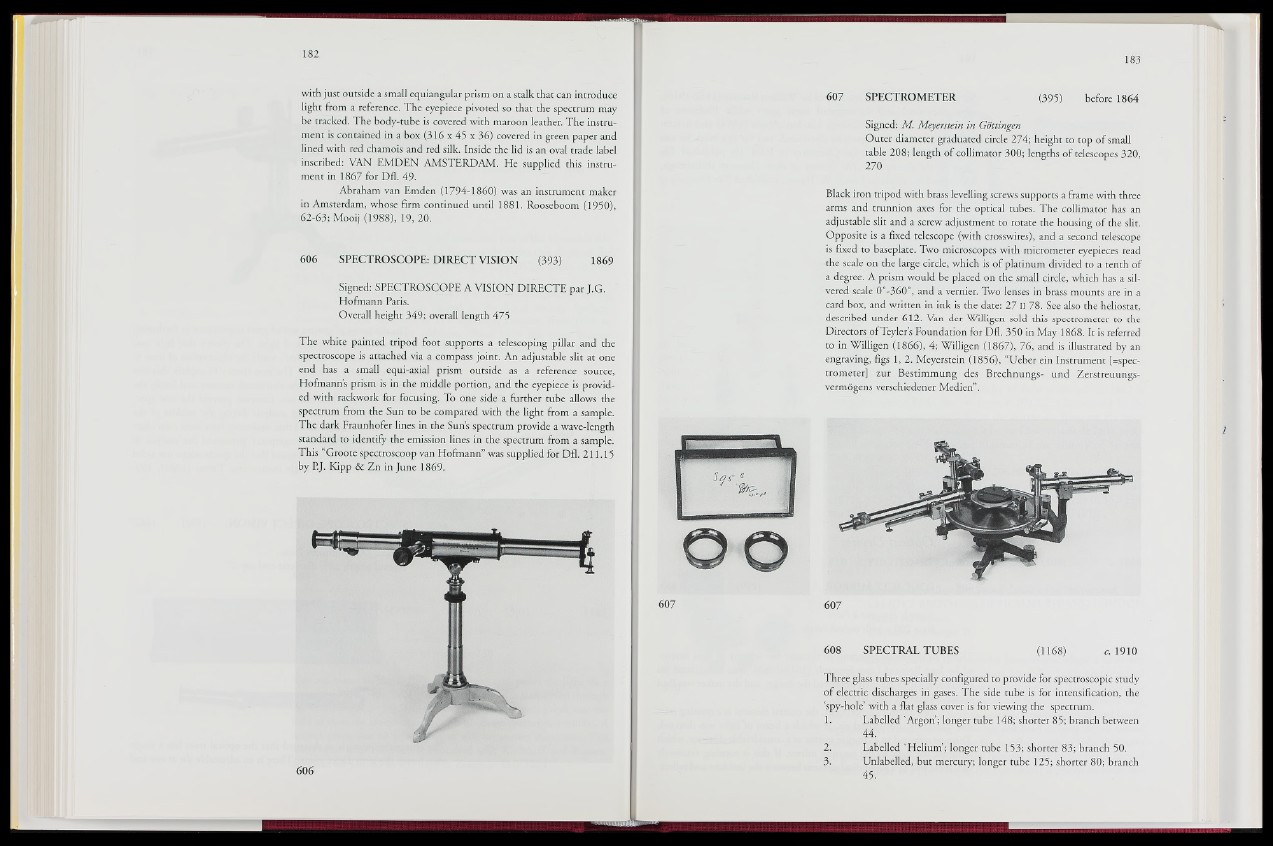
with just outside a small equiangular prism on a stalk that can introduce
light from a reference. The eyepiece pivoted so that the spectrum may
be tracked. The body-tube is covered with maroon leather. The instrument
is contained in a box (316 x 45 x 36) covered in green paper and
lined with red chamois and red silk. Inside the lid is an oval trade label
inscribed: VAN EMDEN AMSTERDAM. He supplied this instrument
in 1867 for Dfl. 49.
Abraham van Emden (1794-1860) was an instrument maker
in Amsterdam, whose firm continued until 1881. Rooseboom (1950),
62-63; Mooij (1988), 19, 20.
606 SPECTROSCOPE: DIRECT VISION (393) 1869
Signed: SPECTROSCOPE A VISION DIRECTE par J.G.
Hofmann Paris.
Overall height 349; overall length 475
The white painted tripod foot supports a telescoping pillar and the
spectroscope is attached via a compass joint. An adjustable slit at one
end has a small equi-axial prism outside as .'a reference source,
Hofmanns prism is in the middle portion, and the eyepiece is provided
with rackwork for focusing. To one side a further tube allows the
spectrum from the Sun to be compared with the light from a sample.
The dark Fraunhofer lines in the Sun’s spectrum provide a wave-length
standard to identify the emission lines in the spectrum from a sample.
This “Groote spectroscoop van Hofmann” was supplied for Dfl. 211.15
by P.J. Kipp & Zn in June 1869.
607 SPECTROMETER (395) before 1864
Signed: M. Meyerstein in Göttingen
Outer diameter graduated oirple 274; height to top of small
table 208; length of collimator 300; lengths of telescopes 320,
270
Black iron tripod with brass levelling screws supports a frame wiSthree
arms and trunnion axes for the optical tubes. The collimator has an
adjustable slit and a screw adjustment to rotate the housing of the slit.
Opposite is a fixed telescope (with crosswires), and a second telescope
is fixed to baseplate. Two microscopes with micrometer eyepieces read
the scale on the large circle, which is of platinum divided to a tenth of
a degree. A prism would be placed on the small circle, which has a silvered
scale 0°-360', and a vernier. Two lenses in brass mounts are in a
card box, and written S in k is the date: 27 II 78. See also the heliostat,
described under 612. Van der Willigen sold this spectrometer to thfl
Directors ofTeyler’s Foundation for Dfl. 350 in May 1868. It is referred
to in Willigen (1866), 4; Willigen (1867), 76, and is illustrated by an
engraving, figs 1, 2. Meyerstein (1856|s!?Ueber ein Instrument [=spec-
trometer] zur Bestimmung des Brechnungs- und Zerstreuungsvermögens
verschiedener Medien’W.ci
607 607
608 SPECTRAL TUBES (1168) c. 1910
Three glassiiiibes specially configured to provide for spectroscopic study
of electric discharges in gases. The side tube is: for intensification, the
®y-hole’ with i flat glass cover is for viewing the spectrum.
< Labelled 'Argon; longer tube 148; shorter 85; branch between
44.
2. Labelled ' Helium’Hbnger tube 153; shorter 83; branch 50.
3. Unlabelled, but mercury; longer tube 125; shorter 80; branch
45.